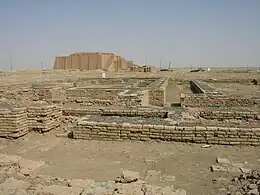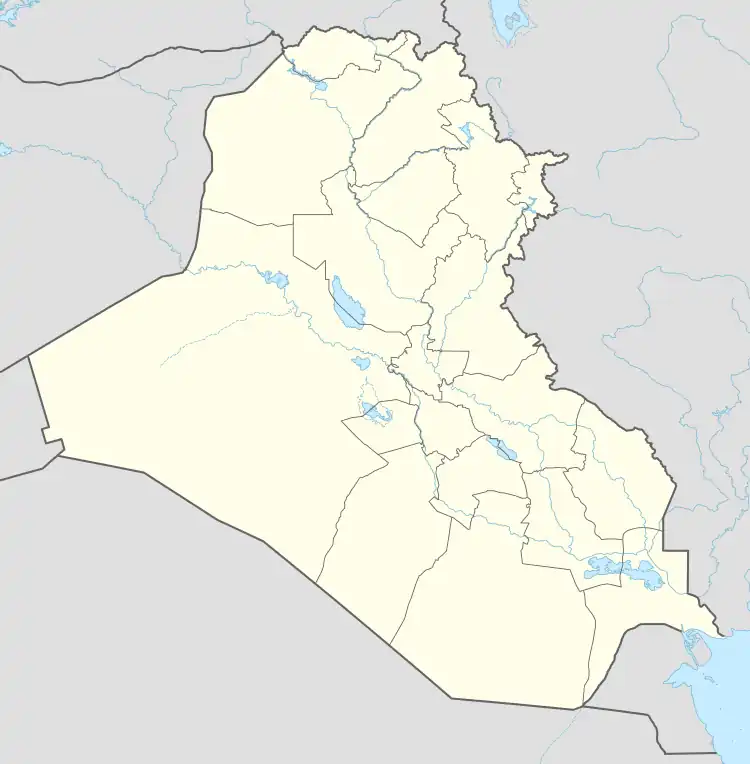 Archeological excavations at the palace grounds | |
 Location within Iraq | |
| Established | Circa 530 BCE |
|---|---|
| Dissolved | 5th century-BCE |
| Location | Ancient Ur |
| Coordinates | 30°57′42″N 46°06′19″E / 30.961667°N 46.105278°E |
| Type | Mesopotamian artifacts |
| Curator | Princess Ennigaldi |
Ennigaldi-Nanna's museum is the earliest known public museum.[1] It dates to circa 530 BCE.[2][3][4][5] The curator was Ennigaldi, the daughter of Nabonidus, the last king of the Neo-Babylonian Empire.[6] It was in the state of Ur, in the modern-day Dhi Qar Governorate of Iraq, roughly 150 metres (490 ft) southeast of the famous Ziggurat of Ur.[7]
Discovery
The museum was discovered in 1925, when archaeologist Leonard Woolley excavated portions of the palace and temple complex at Ur.[5]
He found dozens of artifacts, neatly arranged side by side, whose ages varied by centuries. He determined that they were actually museum pieces, because they were accompanied by "museum labels" — clay drums with labels in three different languages, including Sumerian. [5][8][7][9]
History
The palace grounds that included the museum were at the ancient building referred to as E-Gig-Par, which included Ennigaldi's living quarters[10] as well as subsidiary buildings.[5][11][12]
Ennigaldi's father Nabonidus, an antiquarian and antique restorer,[4] is known as the first serious archeologist.[2] He taught her to appreciate ancient artifacts[4] and influenced her to create her educational antiquity museum.[2]
The artifacts came from the southern regions of Mesopotamia.[4] Many had originally been excavated by Nabonidus and were from as early as the 20th century BCE. Some artifacts had been collected previously by Nebuchadnezzar.[12] Some are thought to have been excavated by Ennigaldi herself.[4]
Ennigaldi stored the artifacts in a temple next to the palace where she lived.[4] She used the museum pieces to explain the history of the area and to interpret material aspects of her dynasty's heritage.[8]
Some of these artifacts were:
References
- ↑ Quinn, Therese (2020). About Museums, Culture, and Justice to Explore in Your Classroom. Teachers College Press. p. 11. ISBN 978-0-8077-6343-8.
- 1 2 3 Anzovin & Podell 2000, p. 69, Item # 1824: "The first museum known to historians (circa 530 BCE) was that of Ennigaldi-Nanna, the daughter of Nabu-na'id (Nabonidus), the last king to Babylonia."
- 1 2 Casey 2009, "Public Museum": "Around 530 B.C.E. in Ur, an educational museum containing a collection of labeled antiquities was founded by Ennigaldi-Nanna the, daughter of Nabonidus, the last king of Babylonia."
- 1 2 3 4 5 6 Dolezal 1987, p. 20: "Princess Ennigaldi-Nanna, collected antiques from the southern regions of Mesopotamia, which she stored in a temple at Ur – the first known museum in the world.
- 1 2 3 4 León 1995, pp. 36–37: "...the first known museum..."
- ↑ McIntosh 1999, p. 4
- 1 2 Woolley & Moorey 1982, pp. 252–259
- 1 2 Encyclopaedia Britannica 1997, p. 481
- ↑ Budge, E. A. (1926). "The Excavations at Ur of the Chaldees". The Book of the Cave of Treasures. p. 275.
- ↑ Woolley 1954, p. 235
- ↑ HarperCollins 1997, p. 23
- 1 2 Nash 2003, p. 12
Sources
- Anzovin, Steven; Podell, Janet (2000). Famous First Facts, International Edition: A Record of First Happenings, Discoveries, and Inventions in World History. H.W. Wilson. ISBN 978-0-8242-0958-2.
- Encyclopaedia Britannica (1997). The New Encyclopaedia Britannica. Vol. 2 (15 ed.). ISBN 978-0-85229-633-2.
- Casey, Wilson (6 October 2009). Firsts: Origins of Everyday Things That Changed the World. DK Publishing. ISBN 978-1-101-15946-0.
- HarperCollins (1997). HarperCollins atlas of archaeology. Borders Press in association with HarperCollinsPublishers. ISBN 978-0-7230-1005-0.
- Dolezal, Robert J. (1987). Reader's Digest Book of Facts. Reader's Digest Association. ISBN 978-0-89577-256-5.
- León, Vicki (1 January 1995). Uppity Women of Ancient Times. Conari Press. ISBN 978-1-57324-010-9.
- McIntosh, Jane (1999). The Practical Archaeologist: How We Know what We Know about the Past. Facts On File. ISBN 978-0-8160-3950-0.
- Nash, Stephen Edward, ed. (September 30, 2003). "Curators, collections, and contexts: anthropology at the Field Museum, 1893-2002". Fieldiana: Anthropology. Field Museum of Natural History. 1525 (36). JSTOR i29782661.
- Woolley, Leonard; Moorey, Peter Roger Stuart (1982). Ur 'of the Chaldees'. Herbert Press. ISBN 978-0-906969-21-2.
- Woolley, Leonard (1954). Excavations at Ur: A Record of Twelve Years' Work. Great Britain: Ernest Benn Limited. ISBN 978-0-8152-0110-6.